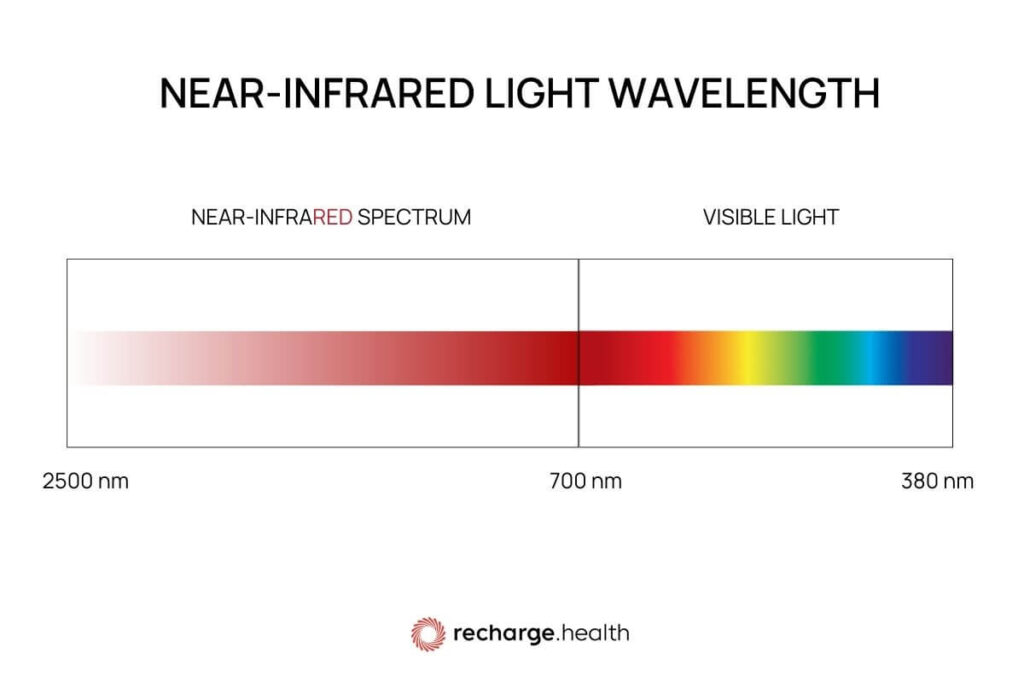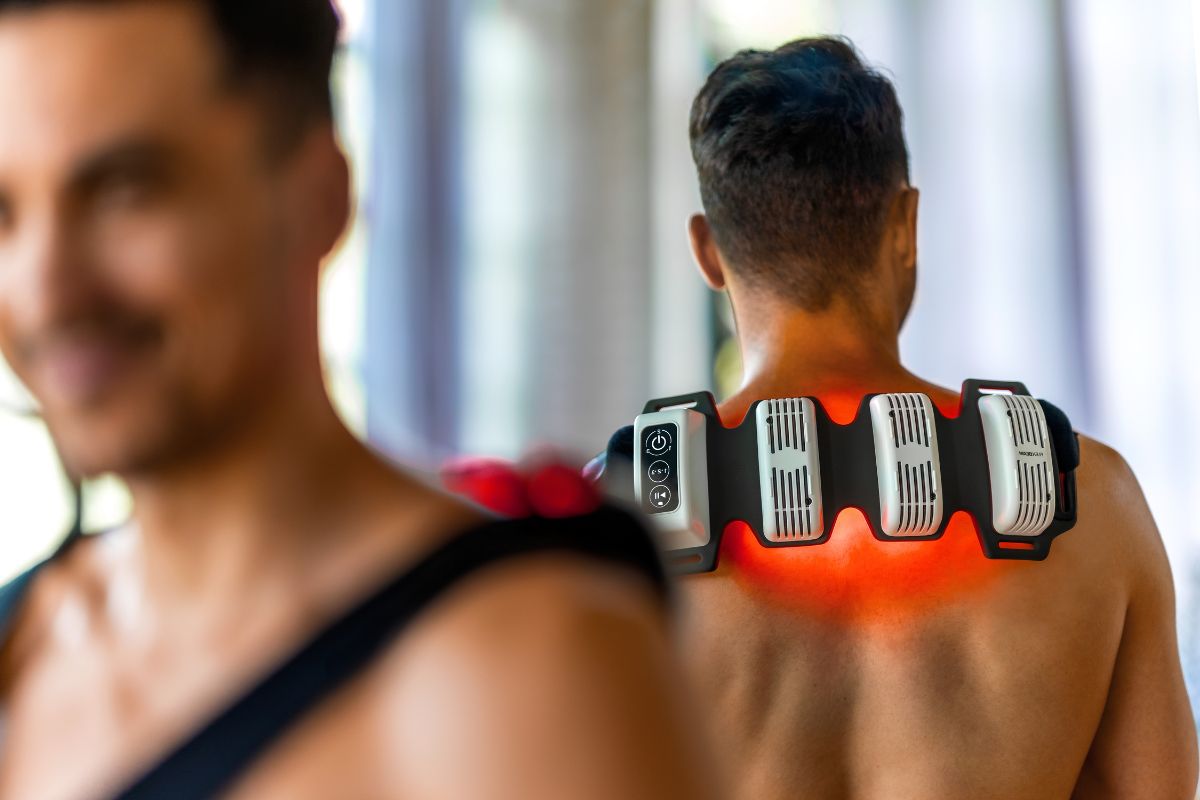Your cart is currently empty!
Is Near-Infrared Light Key to Better Health
Table of Contents
It is commonly believed that a balanced diet, exercise, and regular sleep represent keys to better health. But studies have proven that near-infrared light (NIR) therapy can provide numerous additional benefits that can help you lead a long and healthy life.
Light therapy, officially known as photobiomodulation, is an umbrella term that encompasses a wide array of therapies from different sources and wavelengths that utilize photonic energy for the treatment of various health issues.
Red and near-infrared light therapy, commonly referred to as red LED light therapy, low-level light therapy, or low-power laser therapy, is a type of light therapy that uses light-emitting diodes to produce red light and near-infrared light in order to improve the symptoms of miscellaneous ailments.
Red light and near-infrared light are often banded together, but they actually work in slightly different ways. Here we’re going to explain what exactly NIR is, how it works, and what its benefits are.
What Is Near-Infrared Light?
Perhaps the best way to explain what near-infrared light is is to compare it to the other forms of light therapies, namely blue light and red light.

Blue light wavelengths fall into the visible light spectrum, and they usually range from 380 to 525 nanometers, which means they have limited benefits because they are only effective on the surface of the skin.
Red light wavelengths also fall into the visible light spectrum, but they are slightly longer, usually ranging between 630 and 700 nanometers. They are similarly only effective on the skin surface, which is why they are primarily and very effectively used in skin care.
On the other hand, near-infrared wavelengths fall into the invisible part of the light spectrum and are considerably longer, usually in the 700 to 2,500 nanometers range. Unlike blue and red light, near-infrared light treatments are effective both on the surface of the skin as well as 1.5 inches beyond the surface of the skin and inside the body.
In other words, the longer the wavelength, the deeper it can penetrate into human tissue to stimulate a whole range of bodily functions, including cell, bone, muscle, and organ health. In this way, it is considerably more powerful and effective than blue light or red light therapy.
How Does Near-Infrared Light Therapy Work?
Near-infrared light treatments are done through various therapy devices, such as wraps, panels, and red LED lamps.
- The advantages of portable devices such as Flexbeam is that they are convenient, lightweight, compact, and contoured, meaning they can be fit to all parts of your body.
- These kinds of devices can cover larger areas of the body within a relatively short period of time and achieve uniform irradiation of the skin and muscle tissue.
- They are battery-powered, shielding you from the negative effects of electromagnetic fields that can have harmful effects to your health.
- They do not require any special training so that they can be safely operated by the user in the comfort of their home, without the need for expensive and time-consuming regular visits to a clinic.
- Just as importantly, they are easy to use, target the specific area of the body that you want to heal, and deliver the most effective dose of near-infrared light in terms of energy density and power density.
Not to mention, you can take your device anywhere you go, strap it around the part of the body you want to treat, run errands, exercise, and move around as much as you like.
Treatments with red and near-infrared light devices are safe, non-invasive, gentle and suitable for any skin type. They don’t have adverse side effects, can’t cause burns, skin or tissue damage, or increase chances of skin cancer.
Treatments vary from a 5 to 30 minute session, once or twice a day. How long it will take for near-infrared light therapy treatments to show results is different for every individual and dependent on their specific goals.
However, on average, with regular daily treatments you should expect to see improvements in 4-6 weeks.
Benefits of Near-Infrared Light Therapy
Near-infrared light therapy impacts a whole range of health processes in the body, improving your entire well-being. Those include:
- boosting metabolism
- increasing energy
- reducing inflammation
- reducing cellulite
- speeding up wound healing
- helping skin rejuvenation
- pain relief,
- anti-aging.
To begin with, these wavelengths activate photoreceptor cytochrome c oxidase, a large integral membrane protein encoded in the mitochondrial genome. This, in turn, accelerates wound healing and elevates energy metabolism.
To be specific, NASA found that near-infrared low-level light therapy speeds up wound healing by stimulating the production of growth-factor proteins, collagen, and blood vessels.
Near-infrared light improves mitochondrial energy metabolism and production, which leads to improved recovery from ischemic injury of the heart, and attenuated degeneration of injured optic nerves.
What’s more, near-infrared light can also be used as a safe and effective method of relieving chronic pain and other conditions.
A combination of near-infrared light with wavelengths around 850 nm and high-intensity treadmill training was also found to reduce cellulite, prevent an increase in body fat and the loss of lean mass.
Additionally, a recent study has determined that near-infrared light is a safe, effective, and side-effect-free method of recovery from a wide range of ophthalmological and neurological issues. Those include optic nerve trauma, neuropathy, retinal injuries, pigmentosa, macular degeneration, atherothrombotic stroke, brain injury, and neurodegeneration.
Near-infrared light therapy can also increase the levels of adenosine triphosphate (ATP), an energy molecule that is found in the cells of all living things. This increased production of ATP can help rapid tissue regeneration, improve mobility, and even potentially extend average lifespan, as proven by this study performed on common fruit flies.
These are only some but hardly all of the benefits of near-infrared light therapy treatments. Thousands of studies have proven how near-infrared light affects all the processes in the body, leading to an overall improvement in one’s health.
There is no denying that a balanced diet, exercise and regular sleep are necessary for the body’s optimal functioning but adding near-infrared light therapy to this equation may be just the key that unlocks the secret to better health.
Sources
- NASA research illuminates medical uses of light | NASA spinoff. (n.d.). https://spinoff.nasa.gov/NASA-Research-Illuminates-Medical-Uses-of-Light
- Li WH, Seo I, Kim B, Fassih A, Southall MD, Parsa R. Low-level red plus near infrared lights combination induces expressions of collagen and elastin in human skin in vitro. Int J Cosmet Sci. 2021;43(3):311-320. doi:10.1111/ics.12698
- DeSmet KD, Paz D, Corry JJ, et al. Clinical and experimental applications of NIR-LED photobiomodulation. Photomedicine and Laser Surgery. 2006;24(2):121-128. doi:10.1089/pho.2006.24.121
- Huang D, Gu Y, Liao Q, Yan X, Zhu S, Gao C. Effects of Linear-Polarized Near-Infrared light irradiation on chronic pain. The Scientific World Journal. 2012;2012:1-4. doi:10.1100/2012/567496
- Paolillo FR, Borghi-Silva A, Parizotto NA, Kurachi C, Bagnato VS. New treatment of cellulite with infrared-LED illumination applied during high-intensity treadmill training. J Cosmet Laser Ther. 2011;13(4):166-171. doi:10.3109/14764172.2011.594065
- Zhu Q, Xiao S, Hua Z, et al. Near Infrared (NIR) Light Therapy of Eye Diseases: A Review. Int J Med Sci. 2021;18(1):109-119. Published 2021 Jan 1. doi:10.7150/ijms.52980
- Sarojini H, Billeter AT, Eichenberger S, et al. Rapid tissue regeneration induced by intracellular ATP delivery-A preliminary mechanistic study. PLoS One. 2017;12(4):e0174899. Published 2017 Apr 5. doi:10.1371/journal.pone.0174899
- Begum R, Calaza K, Kam JH, Salt TE, Hogg C, Jeffery G. Near-infrared light increases ATP, extends lifespan and improves mobility in aged Drosophila melanogaster. Biol Lett. 2015;11(3):20150073. doi:10.1098/rsbl.2015.0073
